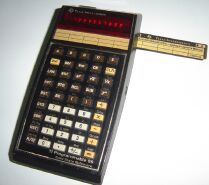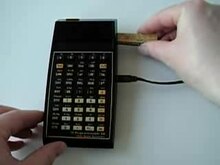TI-59
The TI-59 is a programmable technical and scientific calculator from Texas Instruments with a built-in magnetic card reader . It came onto the market in 1977 as the manufacturer's top model at the time. It was the successor to the SR-52 , which was also equipped with a magnetic card reader .

Chronological order
At the time of market launch on May 24, 1977 by Texas Instruments, the TI-59 was the competitor to the similarly designed HP-67 from Hewlett-Packard , which had better mechanical manufacturing quality, but could only compute about half as fast, with less memory was equipped and also cost about twice the TI-59. The recommended retail price when it was launched in Germany was DM 900, which today, adjusted for purchasing power, corresponds to a sum of EUR 1,120.
A sister model without a magnetic card reader and with only half as much memory, the TI-58 , was offered at the same time. This was replaced in 1979 by the improved TI-58C , which was equipped with a so-called constant memory (for the first time in TI pocket calculators) and whose contents were not deleted when switched off.
At the same time as the TI-58 and TI-59, the TI-57 was introduced, which rounded off the product family at the bottom.
Texas Instruments' main competitor, Hewlett-Packard, responded as early as 1979 with the significantly more powerful, more advanced, but also much more expensive HP-41C , which was equipped with an alphanumeric LC display , non-volatile memory (expandable) and four module slots.
Technical Equipment

The TI-59 is the most powerful TI calculators, still with a red LED - seven-segment display is equipped.
Magnetic card reader
The magnetic card reader can read or write programs or data from cards. To do this, an electric motor pulls the magnetic card past a 4-track tape head at constant speed.
Each side of a card stores a block of 240 bytes. The entire memory of the TI-59 is divided into 4 blocks and the card reader is instructed by a number in the display register (x) which block is to be written. When reading back, the card reader either adopts the position of the stored block or, if a block is specified, it overwrites it if the same block was recorded on the card. Programs can be provided with copy protection when they are written so that they cannot be copied, printed or displayed when they are read in again. It is also possible to read or write the contents of data registers on magnetic cards under program control.
The magnetic cards themselves can be labeled and then inserted into the viewing slot below the display. It can be noted on the card which functions the keys [A] .. [E] and their secondary functions [2nd] [A] ... [E] got by the program.
Solid state software
At the time of its market launch, the TI-59 was the world's first pocket calculator to offer interchangeable program modules based on semiconductors ( ROM ) with permanently programmed application programs ("Solid State Software").
A standard software module ( master library ) supplied as standard contains 25 programs from the areas of matrix calculation, complex functions, integral calculus , geometry , statistics , financial mathematics , conversion of units of measurement, a calendar program, a simple game and a diagnostic program for functional testing the computer and the thermal paper printer available as an accessory.
Texas Instruments themselves and third-party providers developed software for additional modules with which the TI-58/59 models could solve special tasks. A function could load programs individually from the module into the RAM in order to analyze and print them.
As a rule, plastic cards in the format of magnetic cards were supplied with the modules, which, like magnetic cards, could be inserted into the viewing slot below the display (also available on the TI-58 / 58C). The cards were labeled with the assignment of the keys [A] .. [E] and their secondary functions [2nd] [A] ... [E], because during the execution of a module function these keys were redefined by the module function, even if in RAM was a program with different key assignments.
R.A.M.
The main memory can be divided between program and data memory. The division can be changed in steps of 10 data memories or 80 program steps (lines).
- With the TI-59, 960 bytes can be set in 11 steps between a minimum of 160 bytes of program memory and 100 data memories and a maximum of 960 bytes of program memory and 0 data memories. The default settings after switching on the computer are 480 program steps and 60 data memories.
- The memory of the TI-58 / 58C can be divided between 480 bytes and 0 data memories to 60 data memories and 0 bytes of program memory.
- A program step can consist of one or more bytes (lines). Commands with addresses (STO, RCL, ...) require two bytes and jumps to line numbers (GTO, SBR) require 3 bytes.
- A numerical data memory (13 digits mantissa + 2 digits exponent + sign ) occupies 8 bytes.
programming
The TI-59 is programmed simply by pressing the desired key functions in LRN mode. When the program is run, the computer processes the recorded list of keys pressed. The programs created by the user are usually started using keys Ato E(and their second assignments 2nd- Ato 2nd- E).
The TI-59 offers e.g. B. a start / stop function, counting loops , conditional jump commands , subroutines that can be nested multiple times , direct and indirect addressing of data memories or program steps, simple symbolic program marks ( labels ) and program control via 10 simple binary flags .
Addresses (line numbers) can also be jumped to directly with GTO and SBR. This type of addressing offers speed advantages, but jump addresses often have to be corrected when developing the program. In the event that a program becomes shorter, the omitted program steps can be filled with NOP (No Operation). With direct jump addresses it is also possible to only jump to the address in the case of a multi-part command, which can lead to undesirable behavior.
In principle, many commands can be generated by entering an address after STO, for example, and then deleting the STO command again. The HIR registers (hidden registers with the code 82, in which the operands for nested algebraic expressions were partially stored) were addressed.
Display in programming mode
The seven-segment display used cannot display letters. In the programming mode, the program steps are displayed as a two-digit code in addition to the three-digit program step number. The numeric code corresponds to the row and column position of the key pressed on the keyboard.
The numeric codes "00" to "09" correspond directly to the numeric keys 0to for easier readability 9.
To save program memory is u. a. the code for the second assignment of the keys is used as the numerical value of the key position plus 5. Pressing the 2ndkey therefore does not occupy an additional program step.
Some of the numerical codes possible with two decimal digits are used for indirect addressing. B. RCL 2nd Inddisplayed as "73".
The key sequence x² x 3 = R/S RSTcorresponds to the illustration:
| 000 | 33 | x² |
| 001 | 65 | x |
| 002 | 03 | 3 |
| 003 | 95 | = |
| 004 | 91 | R / S |
| 005 | 81 | RST |
To make it easier to read this rather cryptic representation, the computer came with a transparent keyboard overlay with the number codes printed in blue.
Undocumented features
In addition, there are functional undocumented commands such as: B. the HIR commands for direct access to the " H ierarchical I nternal R egisters", which are normally only used internally for bracket hierarchy and statistical functions .
Number format and calculation accuracy
The internal number format is 13 decimal places in exponential representation with 2-digit exponents plus the respective sign. Of these, 10 digits of the mantissa are displayed with a two-digit exponent and the sign, which should make calculation inaccuracies due to rounding errors less noticeable.
The accuracy of the calculation algorithms of this generation of TI pocket calculators is not as sophisticated as that of the main competitor, Hewlett-Packard , who made the transition from the sister models HP-67 and HP-97 to the HP-41C during the market presence of the TI-59 .
Optional accessories
The optional attachable thermal paper printer PC-100C allows not only the expression of calculation results and printing of programs with line-wise listing of alphanumeric key and number code representation and programmatic or manual printing of up to 20 letters and / or numbers per line.
Technical specifications
- ALU (Arithmetic and Logic Unit): TMC0501E - 4-bit CPU, clock frequency 227.5 kHz (or 192 kHz for the TI-58)
- RAM: 4 × TMC0598 with 1920 bits each = 960 bytes
- DSCOM (Double Scanning Read Only Memory): 1 × TMC0582 + 1 × TMC0583 (6 KB each )
- BROM (Bare Read Only Memory): 1 × TMC0571 (6 KB)
- I / O interface for magnetic card reader: TMC0594
- CROM: 1 × TMC0541 as exchangeable solid state software module with 5000 bytes
- Display: 10 + 2-digit red 7- segment - LED display
- Power supply: via the supplied mains / charger or exchangeable NiCd battery (3.6 V)
- Interfaces: 12-pin bit serial interface for the printer PC-100C
- Storage media: Magnetic cards (TI-59 only) with 4-track recording
- Dimensions: approx. 16.3 × 8.2 × 3.7 cm
- Weight: approx. 305 g (TI-58 / 58C: approx. 240 g)
Web links
- TI-59 , TI-58 and TI-58C in the Datamath Calculator Museum ( datamath.org )
- Advertising leaflets (PDF, English) TI-59 (3.9 MB, 6 pages), TI-58 (2.2 MB, 6 pages) and TI-58C (2.0 MB, 6 pages)
- www.ti59.com Pictures and information about the TI-59
- The TI-59 Programmable Pocket Calculator Page for the TI-59 from vaxman.de (engl.)
- Old HP and TI Calculators - HP and TI calculators at www.rskey.org
- TI Manuals - Instructions for various programmable TI computers at www.rskey.org
Individual references and comments
- ↑ The amount was based on the template: Inflation determined, rounded to EUR 10 and relates to last January.




